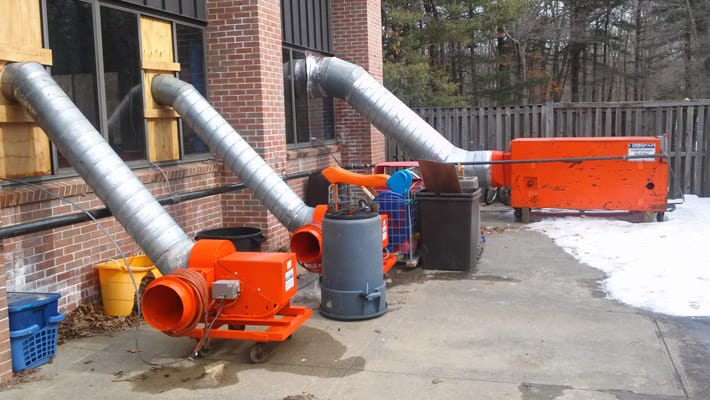
Four Reasons Air Movers are Better Than Air Conditioners
Create a Safe Workspace
The #1 question we get this time of year is about renting air conditioning (AC) units.
In our opinion, AC is a luxury item (think tents for summer weddings and special events). It’s not a necessity for construction.
What we do recommend is ensuring adequate airflow in your structure. A proper air change can create a more comfortable work area in hot summers. Fans, while they may make a person working directly in front of them comfortable, don’t create an air change. Providing proper ventilation throughout a structure will draw air across workers to make them more comfortable. You don’t need fans or AC. Air movers can be used to create positive pressurization, just like BABFAR temporary heaters do in winter, to draw outside air into a structure. Units can be added to exhaust air and further increase air circulation, too.
More importantly, air movers will create a safer workspace, as outlined in a previous blog post about the importance of air circulation in confined spaces. In fact, in these types of spaces, OSHA sets standards for proper ventilation in confined and underground spaces: A minimum of 200 cubic feet per minute (CFM) of fresh air shall be supplied for each employee and 100 CFM per brake horsepower of equipment in the space.*
AC does not provide an air change. Units don’t pull fresh air from outside. Instead, they recirculate air inside a structure to cool efficiently. But, this does nothing to ventilate the space.
Recirculating heaters use a similar approach in winter. While they re-heat the air inside a structure, they also recirculate fumes, dust, particles, and other materials. AC units operate similarly. The units pull inside air over a condenser to deliver cool air. They don’t provide an air change. Nor are they doing anything to remove hazardous materials from the structure.
Another benefit air movers have over AC units is removing moisture. Response teams use a system of fans to create airflow and dry out an area that’s suffered water damage. Nobody uses air conditioning units to clean a flooded basement! Improving airflow can help remove moisture in your structure.
There’s one final consideration: cost. AC units need electricity to run a compressor, fan, condenser, evaporator, and blower. Air movers simply require electricity to power blowers that force thousands of CFM of fresh air into a structure. For temporary enclosures, BABFAR recommends an air change every one to two hours. This means that a 60,000 sq. ft. enclosure, which would represent approximately 600,000 cu. ft. of space, would require an air mover with the capacity of 10,000 CFM or 5,000 CFM, respectively.
For the same reasons OSHA sets ventilation standards for confined spaces, air circulation is important in temporary enclosures. Air movers, sized for the structure, will provide fresh air, keep workers comfortable, and remove moisture and hazardous materials—something air conditioning units cannot do.
* OSHA Safety and Health Regulations for Construction: https://www.osha.gov/pls/oshaweb/owadisp.show_document?p_id=10790&p_table=STANDARDS
Contact BABFAR Temporary Heating Rentals today to learn more about our air movers!




